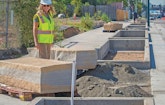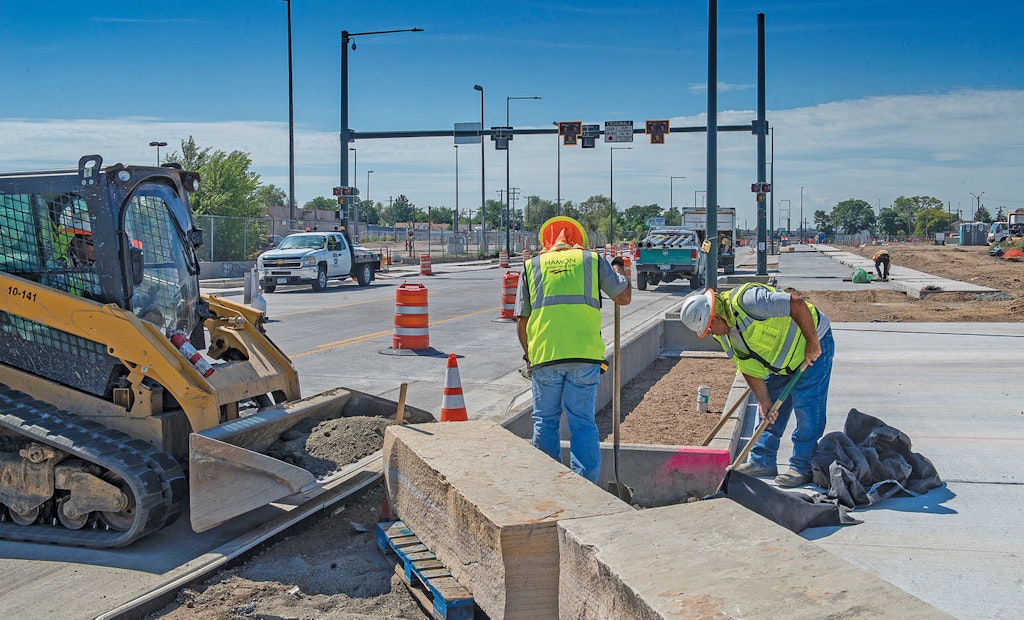Interested in Infrastructure?
Get Infrastructure articles, news and videos right in your inbox! Sign up now.
Infrastructure + Get AlertsColorado’s legal marijuana industry has produced plenty of headlines, but in Denver it’s the city’s green infrastructure program that’s generating buzz.
Denver is going green to control and filter South Platte River Valley stormwater that courses through the urban area after a rain or snowmelt event. The city and county stormwater system is increasingly turning to natural systems and permeable surfaces to slowly infiltrate runoff and separate out pollutants.
“The job currently is focused on water quality, but we are trying to transition to showing that green infrastructure is not just about water quality,” says Sarah Anderson, who manages the green infrastructure program. “It provides a host of citywide benefits, including climate change resiliency, community livability and reduced water demand.”
Emphasis on green handling of stormwater began in 2013 when Anderson joined the Denver team from neighboring Centennial, where she was environmental specialist for the Southeast Metro Stormwater Authority. Denver had just created a position in the Public Works department dedicated to water-quality enhancement and Anderson filled it.
Working together
Denver’s wastewater and stormwater systems are independent of one another. To help fund the green infrastructure envisioned by city-county leaders, annual stormwater rates were increased. The fee now averages $140 a year for a median 7,500-square-foot parcel with 2,750 square feet of impervious surface. The fees generate a dedicated source of funding for water-quality work and support an annual green budget of $5.25 million.
“We’ve been successful in leveraging that money by focusing on doing projects with partners,” Anderson notes. “To date, we have not done any projects on our own. Through cost sharing, we’ve done a lot more infrastructure projects than what $5.25 million can get you.”
Partners include other city departments — transportation and parks — that mutually benefit from the projects. This cross-department cooperation stems directly from the decision to place Anderson’s green program responsibilities in the office of the executive director of Public Works, Eulois Cleckley. “Management has embraced us, which goes a long way,” Anderson says.
“The nice thing about being in the office is that we have the support of the director and chief of staff. Not only do we have upper-level management support, but we can more easily reach across to sister agencies. We have a remarkable relationship with the parks department.”
Anderson notes how one fairly unusable park is being made more functional as a consequence of green infrastructure work and says similar cooperation is happening with transportation and wastewater departments.
Auxiliary benefits
Anderson attributes some of the success to her decision to systematically lay out the impact of green stormwater features to better sell it. She had given thought to the matter just after being hired and before money was available. “I had a little time to think about how I would spend money if the program had money. I thought about how I could invest it and provide more than one benefit, that being water quality. Things like green space and making areas safer for pedestrians and streets more comfortable for everyone.”
The money materialized after the stormwater rate increase in 2016 — “We had some of the lowest fees in the country,” Anderson notes. She prioritized the water-quality basins in the city for such things as pollution loading, urban heat and flood control. “We also looked at some hard numbers such as vehicle miles traveled in a basin, the amount of tree canopy and park density. We gave priority to where green infrastructure was most needed, and today we continue to really try to first focus our efforts on those basins.”
The plan focuses on the six highest-priority basins and a second tier of basins, as well as some special projects. The goal: efficiently and cost-effectively improve surface water quality and produce auxiliary benefits for citizens while doing so.
Driving improvements
Sometimes green infrastructure drives a project; sometimes it complements another department’s project. The city’s River North Park in downtown Denver is an example of the latter. It will boast green space, artwork, play areas, three repurposed buildings and “a water-quality feature.” The water-quality feature is unobtrusively designed into the new park to let runoff from two streets and the impervious areas within the park be filtered by vegetation and other natural materials so what eventually enters a pipe is less polluted.
In the case of a makeover of South Federal Boulevard, Anderson’s green initiative is driving the work. The street is located in a high-priority basin with notably polluted stormwater. What’s more, the street ranks high among Colorado roadways in terms of traffic accidents and fatalities. Teaming with transportation officials, the street will get a $2 million infusion of strategically placed green infrastructure to eliminate turnaround areas, create safer connections, reduce the urban “heat island” effect, and generally improve air and water quality.
“I’m really proud of the Federal Boulevard project,” Anderson says. “It has environmental impact, as well as safety and economic impacts.” Construction begins next fall.
Making strides
To stormwater management traditionalists, such projects are akin to putting a pretty face on an ugly situation. The benefits of green infrastructure improvements are often hard to quantify.
“Our program is a little too new to have hard numbers,” Anderson says. “In the spring, we started monitoring a number of our facilities and that monitoring effort will center around volume reduction and pollution reduction. We’re also trying with university partners (University of Colorado and Colorado School of Mines) to put some methodology in place to track cobenefits of green infrastructure, such as connectivity and safety. That is not as easy to do as monitoring water quality.
“In Denver, we don’t have a great handle on volume reduction numbers for green infrastructure,” she adds. “Sewer system and stormwater managers know how many gallons of water they need to pull out of each pipe to prevent sanitary overflows. We haven’t calculated that yet for green infrastructure. We plan to do some modeling.”
The traditional method of collecting runoff and running it through pipes is commonly called “gray” technology versus her green technology. She says the two have to work together. “Very few people will say you can get rid of the gray system altogether. It is better to have a complement of green and gray systems. That’s one of the next steps. When we come across areas where we don’t have to do gray, we can do green instead. It certainly gets you a whole lot more.”
Public Works officials aren’t ignoring gray infrastructure as the green initiative is being rolled out. Denver is planning several large-diameter storm drain projects. An example is a drain project on 27th Street that will involve 5,900 linear feet of pipe from 78 to 96 inches in diameter.
Cleaning up surface water by filtering it through vegetation targets such pollutants as E. coli. Sources of the pernicious bacteria are both humans and wildlife, according to Anderson. “We have done a lot of E. coli mitigation efforts. It is hard to pinpoint where the efforts are working. It’s tricky. We certainly try a lot of things, and we are making strides.”
Regional leaders
Denver’s long-term stormwater management strategy includes large-scale projects such as entire networks of parks, flood plains and filtration systems that employ natural filters like vegetation, soil and roots. Smaller-scale components of the plan include stormwater planters and so-called green alleys with permeable center strips that collect and filter runoff instead of sending it unfiltered to the nearest collector pipe.
None of these initiatives is revolutionary, new as it might be to Denver. Anderson mentions some cities in the rainy Northwest — “The Portlands of the world” — that have widely adopted infrastructure as green as their landscape. “But in cities located in semiarid parts of the country, the green initiatives have not been prioritized like they have been in other climates. Denver and some other mountain communities in the Southwest are the leaders in pushing this in the region.”
Anderson says Denver’s green infrastructure strategy is not a 10- or 20-year plan.
“I would hope that it would be in perpetuity. The need for these environmental services is not going to go away in 10 year or 20 years. We’ll always have the need.”
Winning over the people
In managing urban water quality and stormwater, giving priority to environmentally correct solutions is not always a crowd-pleaser. As is the case with green energy, some people still consider such proposals nice but impractical. Sarah Anderson, Denver’s green infrastructure manager, has not encountered such resistance … much.
“I do run into that attitude a bit,” she says, but adds, “The hardest thing I’ve had to deal with is when someone says the green projects don’t work or they are too expensive. I always respond that they really are pretty inexpensive when you factor in all the other benefits, including economic and social benefits. This is all studied and researched stuff.”
The traditional green approach typically includes the creation of large detention basins to slow runoff and mitigate some of the pollution it carries. But urban areas like Denver lack available land for new detention facilities. That doesn’t keep the city and county from upgrading what it does have. Anderson talks about a detention basin at 38th and Holly streets that aggravated the neighborhood because it was largely a grassless eyesore.
“People were constantly calling Parks and Recreation to complain about it as it if were a park space instead of a stormwater management basin,” she says. In response, her department and wastewater operations have redesigned the basin with a spillway and meandering natural channel and planted grasses, shrubs and trees. “We have really focused on designing facilities that the community wants. We want to do other projects like that in other neighborhoods.”
In another project along Brighton Boulevard, which connects the city center with Interstate 70, Denver is creating its first green corridor. Along with auto and bike lane improvements, the Public Works crew is planting trees and installing about a hundred street-side stormwater planters. “Businesses are proud of the improvements. From the feedback I’ve received, the neighborhood really likes the planters. They are proud to be the first street to have so many planters instead of the usual curb and gutter and tree lawns.”
In-house, the new approach also has won converts, Anderson says. Reluctance to go green is disappearing among co-workers. “There was a little pushback originally among stormwater employees. Some were a little slow to embrace the newer approach. They questioned whether the urban green infrastructure would really function or if it would be worth the expense.”
They have concluded it was a step in the right direction.









